MXA’S 2013 HUSQVARNA TC250 MOTOCROSS TEST: THERE IS SOMETHING ABOUT THOSE RED HEADS

Q: IS THE BETTER THAN THE 2012 MODEL?
A: Yes, but we’re splitting hairs here. It’s nearly identical to last year’s bike. If our feet were held to the fire and we were forced to say yea or nay, then Husqvarna did enough miniscule improvements to sway us. The 2013 TC250 is better than the 2012 model.
Q: WHAT’S NEW ON THE 2013 HUSQVARNA TC250?
A: We can count the number of 2013 TC250 updates on one hand. Here they are:
(1) Strengthened radiators. The new radiators are from a different vendor and feature additional capacity and bracing. They’re stronger and flow fluid more efficiently.
(2) Magnetic oil-sump plug. In another nod to durability, Husqvarna upgraded to a magnetic plug. Now all of those metal shavings go somewhere instead of cycling through the engine and wreaking havoc.

(3) Mapping changes. Although it’s not listed as a change in Husqvarna’s promo literature, we did some digging and discovered that the EFI mapping was adjusted. Husky concentrated on making the TC250 run cleaner off-idle. Although this change doesn’t result in additional power, the power delivery is smoother (particularly down low in the powerband).
(4) Grips. Normally we wouldn’t make a big deal out of a grip change, but the TC250 has new Domino grips that aren’t terrible. The half-waffle, medium-compound rubber is pleasant and inviting.
(5) Cosmetics. The Italian designers took a crack at making the TC250 look even fancier by creating new in-mold graphics, updating the handlebar pad cover and improving the sticker quality (we’re still not exactly sure what that means).
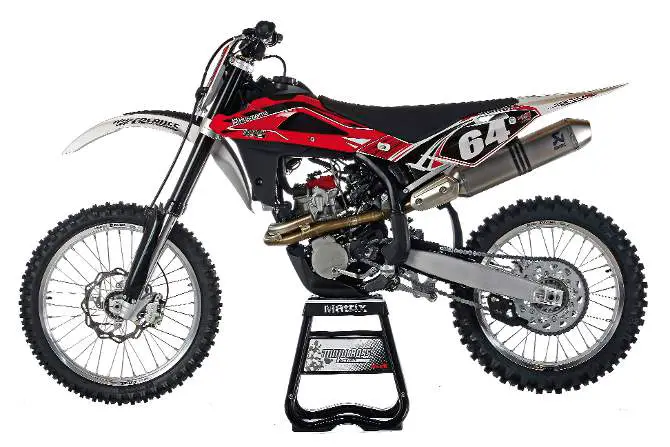
Q: DID MXA EXPECT HUSQVARNA TO RELEASE AN ALL-NEW TC250 FOR 2013?
A: No. We’re not naive enough to think that Husqvarna?or any other manufacturer?should release an all-new bike every year. It’s neither cost-effective nor practical. There’s no such thing as a perfect bike?and all-new models bring with them a whole new set of problems. As a rule, MXA prefers common-sense fixes to the successor of any recently developed model. The goal? Every manufacturer should aim at tidying up the existing motorcycle design while keeping an eye out for new ideas. The 2013 Husqvarna TC250 was an all-new motorcycle in 2010, and it was heavily modified in 2012. Logically, we wouldn’t expect a new Husky TC250 until 2014 at the soonest. But, we do expect flaws to be fixed and improvements to be made, even if the bike isn’t on a timeline to be totally remodeled.
The 2013 TC250 received the least amount of updates since it was introduced four years ago. To us, this signifies that Husky has a new chicken in the hen house for 2014. However, we’ve made many educated guesses before, only to be wrong. Regardless, we’re tickled pink to see that Husqvarna, an Italian company owned by German powerhouse BMW, is reinvigorated and has a renewed interest in the motocross market.
Q: WHAT WILL IT TAKE FOR HUSQVARNA TO COMPETE WITH THE “BIG FIVE”?
A: This is an open-ended question. On the track, it will take a serious focus on horsepower for Husqvarna to battle the “Big Five.” The TC250 has the ingredients for success?not the least of which is Ralf Kleid, who was the head of engine development for BMW’s past F1 effort. And because Husqvarna doesn’t produce the TC250 in high numbers like the Big Five, Husky can make changes on the fly without derailing the production cycle.
Every year Husqvarna has made improvements to the TC250. Just as important, they have listened to feedback?both positive and negative?and addressed those issues instead of turning a deaf ear. Husky seems committed to success in the motocross industry. The TC250 is a prime example of that commitment. It’s not out of the question that Husqvarna could hit one out of the ballpark in the not-too-distant future and catch the Big Five off guard. After all, that is what the Austrians did. We’re rooting for them.
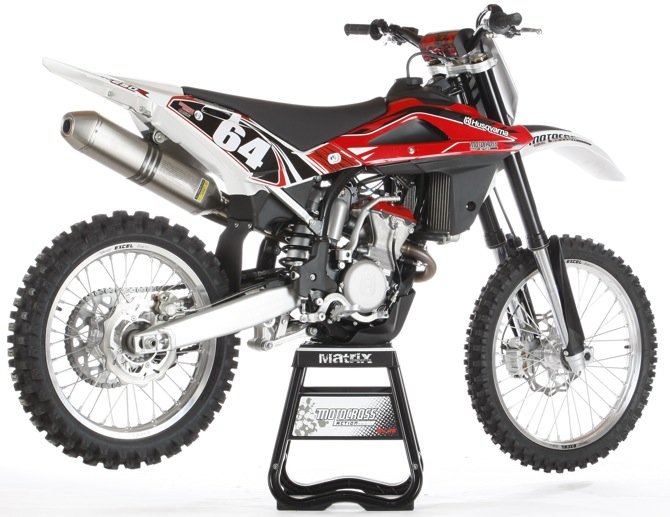
2013 Husqvarna TC250: The Italians didn’t go overboard with updates, but instead focused on reliability and comfort.
Q: WHAT NEEDS TO BE CHANGED ON THE 2013 HUSQVARNA TC250?
A: The TC250 has come a long way, but there are still a few bugaboos. Let us pinpoint the problematic areas:
(1) Engine. The Ralf Kleid-massaged “Red Head,” named after the red powder-coated cylinder head, was new in 2012. The engine, fed with fuel via Keihin electronic fuel injection, is a double-overhead-cam design with a lightweight piston. The finger-follower valve train of the Red Head replaces the previous shim-and-bucket design. The (new-for-last-year) cams allow for a longer valve lift, while larger-diameter titanium valves get the air and fuel moving quicker. We like the mechanically sound finger-follower design?and we can’t forget the petiteness of the X Lite engine?but the TC250 engine is slow. The powerband is broad and easy to ride, but it takes a rev ranger to make the TC250 move forward with the rest of the pack.
(2) Kayaba Forks. The beauty of the fork design is that any backyard mechanic with gumption and time can find the sweet spot for fork setup (granted, he could also royally screw up the settings). The Kayaba forks on the TC250 aren’t groundbreaking new technology, but that’s not a bad thing. You won’t need a Schrader pump or tape measure to properly set up the TC250 forks. Instead, you’ll need a screwdriver and a measuring cup, because it’s imperative to remove excess fork oil through the air bleeder holes. By our measurements, the Kayaba fork legs have 20cc too much oil for the average rider.
The high oil height prevents the forks from moving through their stroke. As a result, the front end has difficulty sticking in corners, which led test riders to do the dreaded stomp-and-turn. What is that? Don’t confuse it with the turn-and-stomp, made famous by the last generation of Kawasaki KX250 two-strokes. Stomp-and-turn describes the sensation of not being able to initiate steering into a corner, causing the rider to stomp his foot and then pivot off of that point. It’s a terrifying experience. Only after we reduced the oil height did the forks move, then the TC250 cornered better.
Q: HOW DOES THE 2013 HUSQVARNA TC250 COMPARE TO THE COMPETITION ON THE DYNO?
A: Maximum horsepower on our 2013 TC250 was 37.86 ponies at 11,000 rpm. To compare, both the KTM 250SXF (42.89 horsepower) and the KX250F (41.16 ponies) put serious hurt on the Husky TC250. However, the pride of Italy does beat the Yamaha YZ250F (37.13). The TC250 and YZ250F practically mirror one another on the dyno curve, except that at high rpm the TC250 pulls away slightly.
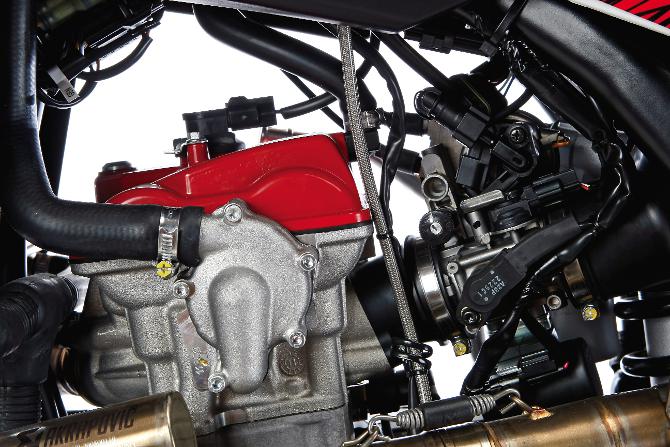
Redhead: The TC250 is known for its red cylinder head cover and small engine design.
Q: WHAT DID WE DO TO IMPROVE THE 2013 HUSQVARNA TC250?
A: The fixes are relatively few but important. Make these changes to find happiness with the TC250.
(1) Gearing. The 13/50 combination doesn’t cut it, especially with the misplaced powerband. We geared the TC250 down by adding a tooth to the rear sprocket. On very tight tracks, we recommend going up two teeth, but in most cases, invest in one more tooth.
(2) Forks. Heavens to Murgatroyd, drop the oil height! Do so or be doomed to face a riding experience where going straight is the only safe option. Break out the screwdriver and pump oil out of the forks to get the forks to travel through their stroke.
(3) Exhaust. The Akrapovic exhaust, with its built-in resonance chamber on the head pipe and carbon fiber muffler support bracket, looks nice. Unfortunately, nice won’t get you to the first turn first. This is not a very good pipe?even though it is a brand name. Husky should build their own exhaust systems, because we think they could do as good a job as this pipe?and then they could lower the price of the bike. If you are a 2013 Husky TC250 owner, invest in an aftermarket exhaust system. After testing Andy Jefferson’s TC310 prototype, we opted to run the exact same 94 dB Pro Circuit exhaust system that he uses. It was good for a couple ponies. (www.procircuit.com).
(3) Mapping. Husqvarna has a deal with GET to produce a complete reprogrammable ECU system for their aftermarket division. Although it is quite costly, we installed the GET ECU along with the GET GPA (traction control) system. This allowed us to resolve some jetting issues that we were having because we could remap the GET unit at the track. We ended up going 4 percent richer (with the Pro Circuit exhaust) and again gained more power. At high rpm the stock ignition gets fluffy and starts to waver at 11,000 rpm. With the GET ignition, there is more power after 11,000 rpm and the difference by 12,000 is in the four horsepower range. One caveat; the Husqvarna GET black box retails for $710.38. That may seem like a hefty price tag, but MXA‘s electronic trickery didn’t end at that price point. We added more GET magic?GPA control. For $243.12 we added the GET GPA control. The GPA control is a ten click dial that lets you control power output by monitoring runaway revs. Rather than dance around what the GPA control does?it is, in plain language, traction control. We typically ran it on 3 or 4 clicks out.
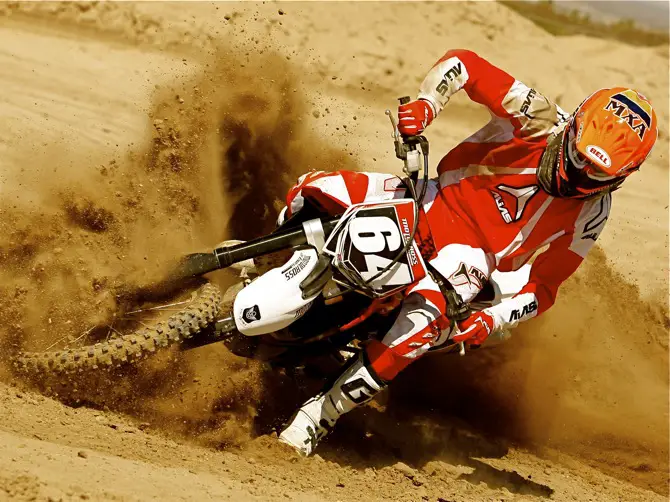
Q: HOW MUCH DOES THE TC250 WEIGH?
A: Don’t be confused by the X Lite engine. The TC250 is a chubby buddy. We blame the weight on the steel frame, Michelin Starcross tires, hubs and gallons of fork oil. What’s odd is how light and slender the TC250 looks. The Italian styling, with sharp lines and minimal real estate for graphics, makes the bike stand out from anything else on the market. The Akrapovic exhaust, routed down the left side of the bike, adds flair. These attributes, however, don’t do anything for the weight. The 2013 TC250 weighs 229 pounds. It isn’t the heaviest 250 four-stroke (the 2013 KTM 250SXF, at 231 pounds, earns that distinction), but it’s 5 pounds heavier than the Kawasaki KX250F and 11 pounds more than the Yamaha YZ250F.

On the dyno: The 2013 TC250 reached 37.86 horsepower. On the track, the bike feels slow due to a tall sprocket.
Q: HOW MUCH DOES THE TC250 COST?
A: A big plus of the 2012 Husqvarna TC250 is its retail price. At $7199. The Husky is $700 cheaper that the most expensive 250 four-stroke bike and $91 cheaper than the next cheapest retail price.
Q: WHAT DID WE HATE?
A: The hate list:
(1) Engine. We like the Red Head concept, but just like Little Orphan Annie, we were hoping for a great story with a happy ending. The X Lite engine finishes strong, but it takes forever to get there.
(2) Number plates. What number plates?
(3) Forks. If you don’t fiddle with the fork oil, then you’ll never realize the full potential of the TC250. Thankfully, dropping the oil height is a free and simple fix.
(4) Exhaust. We think the Akrapovic exhaust is holding the powerplant back. An exhaust that focuses on boosting midrange power would be better suited to the TC250.
(5) Gearing. European motorcycle manufacturers love drag-strip gearing, and the TC250 is no different. Add a tooth to the rear sprocket to maximize the powerband.
(6) Weight. With the Yamaha YZ250F weighing 218 pounds, 229 pounds for the TC250 is porky.
(7) Plastic. We actually had roost blow holes in the front fender. The plastic formula is very brittle.
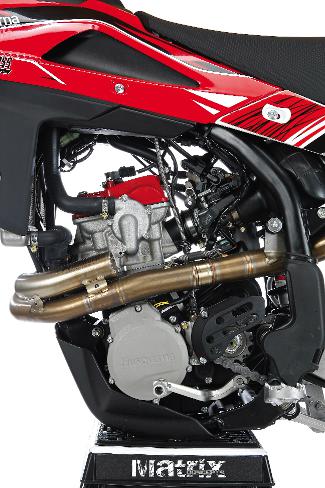
Chamber of secrets: The TC250 comes with an Akrapovic exhaust. It was ho-hum. Note the increasingly popular resonance chamber.
Q: WHAT DID WE LIKE?
A: The like list:
(1) Uniqueness. If you’re looking for something different, the Husqvarna TC250 is for you. It garnered a lot of attention when we pulled into the pits?and even more accolades when we won races on it.
(2) Frame. It’s on the heavy side, but the TC250 frame handles nicely. Let’s not forget how the narrow steel frame makes it easy to reach the shock collar and throttle body.
(3) Front brake. You can’t go wrong with a Brembo dual-piston caliper matched with a 260mm Braking rotor.
(4) Grips. We’re picky. Last year the Domino grips spun on the handlebars, and we didn’t like the compound. The new grips are quite a bit better.
Q: WHAT DO WE REALLY THINK?
A: Husqvarna is quickly becoming a player in the 250 four-stroke market. They have drastically improved the TC250 in recent years. And though it’s not a world beater, the Italian machine is competitive. It will take a competent racer at the top of his game to knock off the competition (considering that the KTM 250SXF and KX250F are playing in a different league when it comes to horsepower), but it’s possible. That couldn’t be said two years ago. Husqvarna is going places.
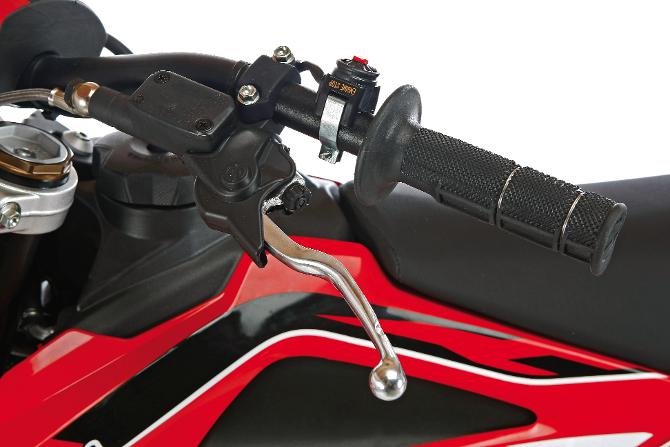
Smooth as snot: In years past we had problems with the TC250’s hydraulic clutch. That isn’t the case for 2013. The Brembo unit works very well.
MXA HUSQVARNA TC250 SETUP SPECS
This is how we set up our 2013 Husqvarna TC250 for racing. We offer it as a guide to help you get your own bike dialed in.
KAYABA FORK SETTINGS
These forks are beefy. This wasn’t always the case. In 2011 Husqvarna used way too light 0.43 kg/mm springs. Last year they jumped up two spring rates to 0.47 kg/mm. It was a good idea, but adding 20cc of oil was the kiss of death. The forks were jarring because they weren’t moving through their stroke. This dramatically affected handling. We removed 20cc of oil and backed out the compression clickers to put the forks within the zone of a typical 250F rider. For hardcore racing, we recommend this fork setup on the 2013 Husqvarna TC250 (stock specs are in parentheses):
Spring rate: 0.47 kg/mm
Compression: 16 clicks out (12 clicks out)
Rebound: 12 clicks out (10 clicks out)
Oil height: 290cc (310cc)
Fork-leg height: 5mm up
Notes: A bigger, faster rider will still benefit from removing fork oil, but should start with the stock clicker settings. A minicycle transplant may need softer springs.
KAYABA SHOCK SETTINGS
MXA test riders became comfortable with the old Sachs shock on the TC250, but Husqvarna decided to go with Kayaba last year. For 2013, the TC250 has the same shock and settings. We noticed that there was a slight looseness to the way the rear end tracked over bumps. To remedy the problem, we went out on rebound, but that led to more hopping. So, we went the opposite direction, which deadened the feel of the shock but didn’t solve the riddle. Eventually we determined that the looseness was most likely frame flex. For hardcore racing, we recommend this shock setup on the 2013 Husqvarna TC250 (stock specs are in parentheses):
Spring rate: 5.3 kg/mm
Hi-compression: 1-1/2 turns out (1-1/4 turns out)
Lo-compression: 14 clicks out
Rebound: 6 clicks out (10 clicks out)
Race sag: 100mm

Leftie: The TC250 exhaust system is routed down the left side of the bike. It’s another feature that differentiates the bike from the competition.


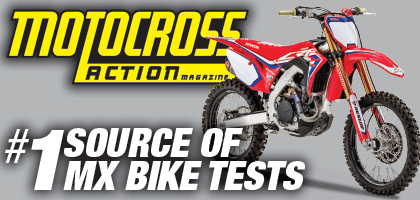


Comments are closed.